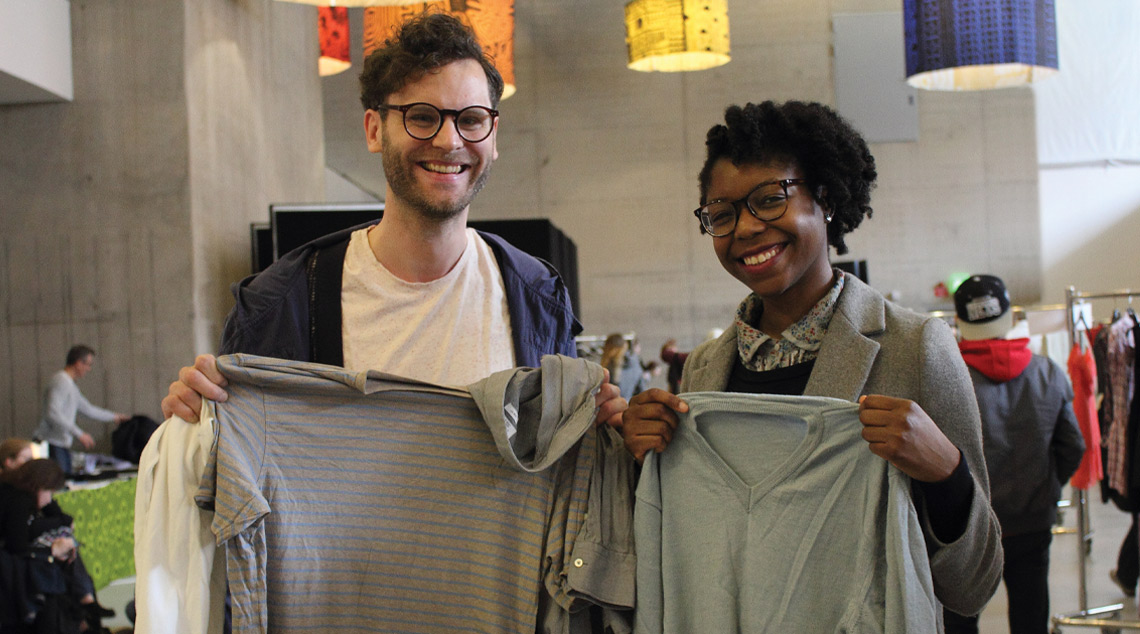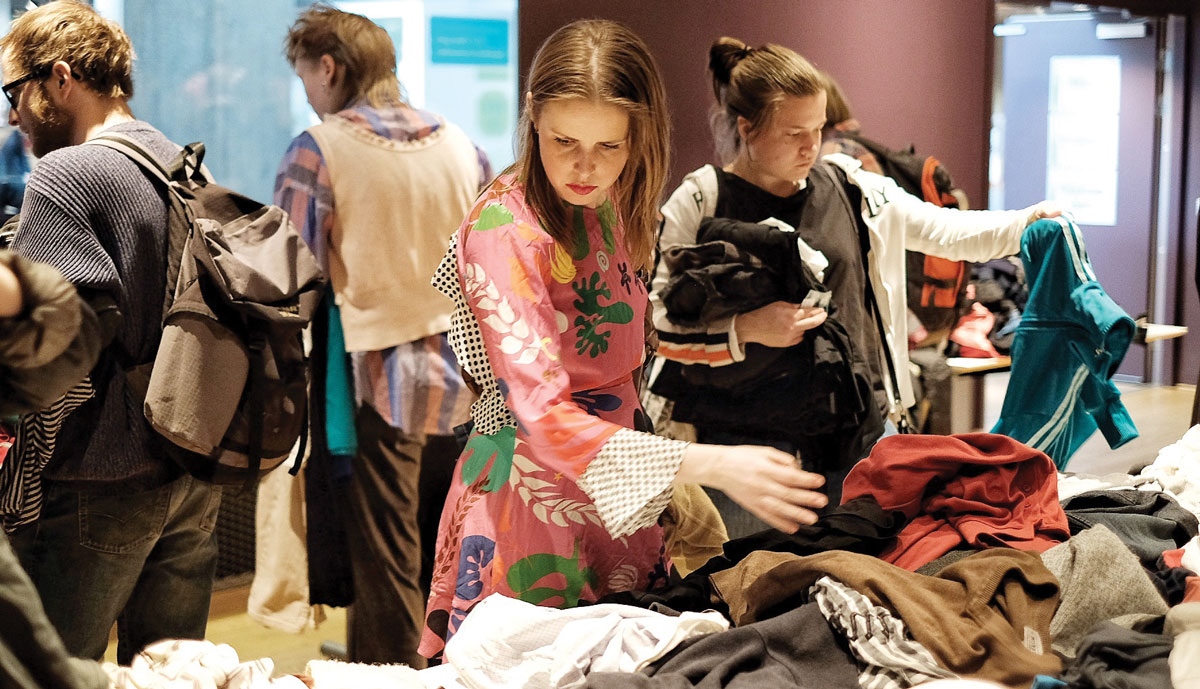
A contribution by SSNC
SSNC works with 40 organisations around the world to disseminate knowledge, shape public opinion and influence decision-makers to bring about change. Based in Sweden with 24 county branches and 270 municipality subdivisions. It has more than 200 000 members.


Can swapping clothes transform societies?
It is morning, you have just gotten up and are making breakfast. You are feeling good about yourself because you recently have switched to using organic coffee and have started eating more vegetarian meals to cut your meat consumption. You put your plastic in the recycling bin and compost your organic waste. These actions have all become routine in your daily life. You want to do your part – and it is relatively easy. Then you open your closet and your self-esteem fades. It’s filled to the brim, but still doesn’t give you the options you need.
This motivates you to buy something new, something brighter, something to echo how you are feeling about life right now. On your way to the shops and as the sun hits your face, you reflect on the unseasonably hot weather and lack of rain. Is this climate change you think to yourself?
Increasingly, your fellow citizens are viewing climate change as a severe problem and are changing their lifestyles accordingly. They are eating less meat and are starting to travel less – even before COVID-19 put an end to many common lifestyle practices.
What hasn’t changed though is that people continue to buy clothes – not because we need to, most in the Global North have plenty, but because we feel we have to.
Consequences of clothing consumption
Global value chains enable a world of consumption right at our fingertips. The negative environmental impact of this model is enormous. And while having an ‘exploding’ closet might be appealing, the consequences, as usual, are felt by the natural environment and the world’s poor – the textile workers producing our clothes and the farmers working in pesticide-infused cotton fields.
The clothing and textile industry contributes significantly to greenhouse gas emissions. Producing and processing textile fibres consumes an enormous volume of water, and this water is often drawn from countries already suffering water shortages.
Global clothing production has roughly doubled since 2000 – and only 1% of all clothing is recycled into ‘new’ textiles; one garbage truck of clothes is burned or landfilled every second.2
Fast fashion, produced and consumed at an incredible speed, is a response to high levels of sensitivity to changing fashion trends and it amplifies inferior quality throughout the value chain.
When fast-changing fashion trends make you throw away clothing, there is an unnecessary loss of valuable materials. There is a clear need to find more efficient ways of organising the delivery of the service that clothes provide, transforming our behavioural patterns and business models to support production that delivers long-lasting, repairable and recyclable clothes. This is where clothes swapping comes in.
A focus on bottom-up change
We know that small-scale actions can lead to greater change. SSNC has worked to encourage consumption of organic products, helped to rid laundry detergents of pollutants and has contributed to banning several toxic pesticides from Swedish and European fields. We have also arranged clothes swapping events in Sweden since 2010.
In just nine years, this initiative grew from 36 events in Sweden to 305 in the Nordic countries. Our most recent event saw 58 000 garments receive new owners, saving 43 tons of chemicals, 406 tons of carbon dioxide and the equivalent of 400 000 filled bathtubs of water. Clothes swapping is starting to gain popular appeal; it strengthens advocacy for a circular and sustainable fashion industry and raises awareness of smarter ways of consuming clothes.
Small-scale change creates ripples and ripples become waves shaping popular opinion.

A need for both efficiency and sufficiency
There is a tendency to prioritise efficiency solutions in policy focused on sustainable consumption. Policy formulations also need to focus on the value of sufficiency. Rebound effects – also known as the Jevons paradox – mean that any efficiency gains, resulting in lower prices, will concurrently grow consumption if sufficiency is not integral to policy and messaging around sustainable consumption.
But who is responsible for the unsustainable production and consumption of clothing? How can consumer behaviour shift in a value-driven rather than guilt-driven way?
“I brought my 12-year-old and very reluctant daughter to a clothes swap. But once there, she found a pair of jeans of a brand that we couldn’t afford to buy new. That was a shift for her and now it’s imprinted in her mind that swapping is a possibility.”
Karin, clothes swapper
The small steps matter. We need to rethink and re-evaluate our roles, not only as consumers but as citizens, to understand that how we consume might have a bigger reflection of our identity than what we consume.
We can play a transformative role in a much bigger system through what goods we purchase and how. We can make sure that what we consume is circulated back into the system. Clothes swaps are mechanisms to circulate – and then recirculate – clothing. They are the first steps for many into a world of sufficiency and sustainability.

Clothes swapping serves as a powerful vehicle to raise awareness of the patterns of unsustainable production and consumption. Credit: Monica Olsson/SSNC.
Children today live in a tension created by a constant influx of ‘influencer content’ and the ever-increasing risks posed by climate change. They must navigate the need to fit in and to take on the responsibility for the environment that has been unfulfilled by previous generations.
Clothes swapping has the potential to reduce the consumption of new clothes, but it also serves as a powerful vehicle to raise awareness of the patterns of unsustainable production and consumption in a creative and fun way. By shifting the perception of unwanted clothes from ‘trash’ to something with value for someone else, clothes swapping events are an entry point to new consumption behaviours. And since the goal is to use, not to own, these events open up a world of possibilities in challenging norms around satisfaction, ownership and consumption.
Being part of something bigger creates a sense of belonging leaving one with a sense of accomplishment. This is how transformation happens.
- World Wildlife Foundation. 2013. ‘The impact of a cotton T-shirt.’ [Online] Available: https://www.worldwildlife.org/stories/the-impact-of-a-cotton-t-shirt.
- Ellen MacArthur Foundation. 2017. ‘A new textiles economy: redesigning fashion’s future.’ [Online] Available: http://www.ellenmacarthurfoundation.org/publications.

